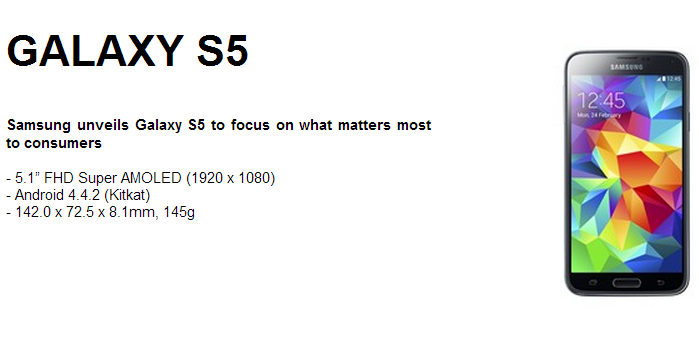Samsung Galaxy S5, a refined and updated take on last year’s wildly successful Galaxy S4, will land on T-Mobile U.S.
Like the new Gear wearables, the Galaxy S5 looks and feels familiar, but offers a number of improvements over last year’s edition.
What’s New
The Galaxy S5’s design is a minor evolution of the Galaxy S4. The S5’s display is ever so slightly larger at 5.1 inches, but it’s still a 1080p, Super AMOLED panel that doesn’t look very different from the S4’s screen.
Samsung has retained the familiar metal-looking plastic surround on the S5, though the charging port (now USB 3.0) comes with an integrated port cover for waterproofing.
Samsung has replaced the S4’s slimy, glossy plastic battery cover with a dimpled soft-touch finish.
S5’s new finish reverses this trend and is one of the most significant upgrades introduced this year.
Samsung is offering the S5 in four different colors — black, white, blue, and gold.
The S5 is launching with Android 4.4.2 KitKat with Samsung’s user interface
The company is taking a more low-key approach with the Galaxy S5.
On 4G networks
The Galaxy S 5, Gear 2, Gear 2 Neo and Gear Fit will be available to U.S. consumers this spring across various channels. AT&T, Sprint, T-Mobile, Verizon Wireless, MetroPCS and U.S. Cellular will carry the Galaxy S 5.
The Galaxy S 5 also offers S Health which enables consumers to access health info, track and map workouts and make and track healthier eating choices right on the device.
Samsung is betting big on wellness, fingerprint reading and camera autofocus, while keeping a very similar look and feel for its hardware and software. The updates are so minor that on first glance most consumers would be hard pressed to notice that it has changed from the previous version.
Still, this should come as no great surprise, given the maturity of the smartphone market and the pressure on the Samsung not to mess with its winning formula. Samsung reminded us quite how successful this formula has been, noting that it has sold 200 million Galaxy S devices since launching the franchise in 2010.
Ovum on Galaxy S5
Nick Dillon, senior analyst at Ovum, said: “In contrast to the Galaxy S4 which was packed with gimmicky features, Samsung has focused instead on a small number of enhancements with the S5. The challenge for Samsung will be to convince users to upgrade to a handset that offers little more than its predecessor.”
PayPal and Samsung have extended their collaboration with a new biometric feature that will allow users of the new Galaxy S5 smartphone to use fingerprint authentication for mobile payments with PayPal merchants. PayPal argues that this is a major innovation in m-payment, introducing a new level of convenience for consumers compared to the familiar login-and-password authentication model.
Like the 5S, the S5’s home key features an integrated fingerprint scanner, which can be used to unlock the phone or authenticate purchases online. Samsung’s version requires a vertical swipe over the home button to activate the scanner.
Eden Zoller, principal analyst at Ovum, said: “We think consumers will be wary and need some convincing due to security concerns. In Ovum’s 2013 Consumer Insights Survey, almost half the survey respondents (49 percent) ranked lack of security as their priority concern with mobile payments. Consumers already worried about the security of established m-payment mechanisms are likely to view a new technology and process with suspicion.
The PayPal fingerprint authentication feature will go live on the Samsung Galaxy S5 in 26 markets this April. PayPal expects more device manufacturers to adopt the technology going forward.
Frost & Sullivan on Galaxy S5
Guilherme Campos, senior consultant for Latin America ICT, Frost & Sullivan, said: “After Motorola and Apple submit their phones with biometric readers, it was the turn of Samsung join this trend during the launch of the Galaxy S5 – just at the time when security concerns about this technology start to be dispelled.”
The back of digital readers, now applied in smartphones, meets the increasing need for security of transactions made on smartphones. People are becoming accustomed to using their mobile phones to make purchases and banking transactions, and this movement will continue to grow. In Brazil, for example, by 2018 more than 80 million users are registered and using mobile payment solutions.
Among other new features of this new version you can also highlight the integration between your smartphone and your smart digital clock and resistance waterproof device.
Baburajan K
[email protected]






